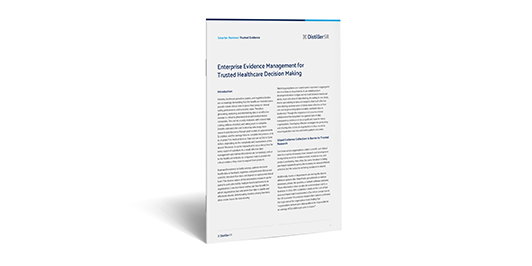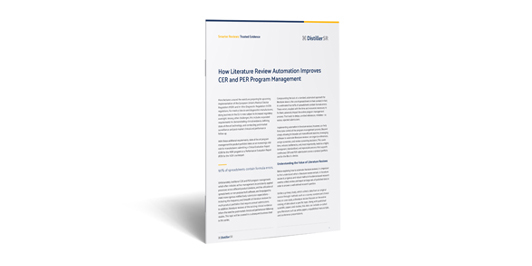Case Study
Stryker Improves Literature Evidence Management Efficiency by 70% with DistillerSR
DistillerSR integrated fully into Stryker’s T&E Clinical Affairs technology ecosystem and enabled more accurate insights and expedited decision-making processes.

Significant Efficiency Gains
The implementation of DistillerSR significantly enhanced Stryker’s T&E efficiency in literature review and evidence management. The platform standardized forms and templates, minimized manual tasks, and streamlined processes from initial screening to data extraction, and creation of clinical evaluation documents to support regulatory submissions.

Enhanced Compliance and Data Management

Improved Cross-Functional Collaboration
Sepanta explained: “Microsoft Access followed a tabular dataset framework, which, at the time, was quite advanced,” he said. “However, as we expanded our team to manage the increasing number of reviews, we spent a lot more time creating forms, labels, dropdown menus, and other elements. This time-consuming process not only put a huge strain on the system but also led to data inconsistencies. Additionally, we had to manually connect the references stored in the company library database. When we assessed the time spent on these manual tasks and the risk of errors, we quickly realized that Microsoft Access was not a viable long-term option.”
“The introduction of the new medical device regulation (MDR) motivated us to reevaluate our processes and improve operational efficiencies. As we navigated MDR, we encountered significant data growth and increased complexity, alongside a rapidly expanding team. This steep learning curve prompted us to move away from our Microsoft Access database and look for a more reliable and robust system. Consequently, DistillerSR emerged as a foundational step in our strategy to enhance efficiency and compliance.”
The introduction of the European Union Medical Device Regulation (EU MDR) required stricter compliance and comprehensive documentation throughout the device lifecycle. In response to these growing complexities, Stryker’s Trauma & Extremities division recognized the need to adopt a more robust, efficient, and scalable platform. DistillerSR proved to be an ideal solution to meet these heightened demands.
According to Sepanta: “The introduction of the new medical device regulation (MDR) motivated us to reevaluate our processes and improve operational efficiencies. As we navigated MDR, we encountered significant data growth and increased complexity, alongside a rapidly expanding team. This steep learning curve prompted us to move away from our Microsoft Access database and look for a more reliable and robust system. Consequently, DistillerSR emerged as a foundational step in our strategy to enhance efficiency and compliance.”
In this new regulatory landscape, the volume and complexity of data required for EU MDR–compliant clinical evaluation reports (CERs) grew exponentially. This increase equalled the extensive documentation needed for each medical device throughout its lifecycle, from pre-market approval to post-market surveillance. As our portfolios expanded, the need for a centralized and efficient management of literature review processes and extracted data became paramount.
DistillerSR equipped Sepanta and his team with a robust and reliable solution tailored for comprehensive medical device lifecycle traceability, from product development to post-market analysis. This audit-ready system streamlined submissions and enabled rapid, accurate responses to inquiries from notified bodies. The overall confidence in regulatory submissions was significantly enhanced, and the use of standardized protocols, templates, and forms boosted efficiency and productivity. Sepanta noted: “By standardizing our forms and templates in DistillerSR, we have significantly streamlined the literature review processes, from initial screening to data extraction and the creation of clinical evaluation documents for regulatory submissions. Sepanta continues: “We have identified specific families of devices with similarities in labeling and indications, and overlapping search results. This allowed us to reuse extracted data across these similar products. As a result, we have achieved an estimated 70% improvement in efficiency since adopting DistillerSR.”
In large organizations like Stryker, data is often managed in silos by different functional teams, such as clinical, regulatory, HEOR, and marketing. This compartmentalization leads to redundant efforts, inefficiencies, increased costs, and inconsistent findings across departments. Implementing DistillerSR enabled Sepanta and his team to adopt a holistic approach to evidence data collection, management, analysis, and sharing. They engaged cross-functional stakeholders to leverage previously extracted literature review data and collaborated with other business units to share standardized workflows and improve overall efficiency. In the context of CERs, the reuse of templated forms and dropdown menus for reference inclusion and exclusion facilitated efficiency gains across multiple groups and business units.
“In our Trauma and Extremities division, we successfully created standardized forms and templates in DistillerSR, enabling data reuse and enhancing efficiency,” Sepanta explains. “Over the past few months, we have also started to share our best practices and methodologies with other divisions using DistillerSR.” This collaboration has been highly productive and represents a step towards harmonized practices across the organization. We are moving beyond a save-and-store data mindset and establishing a dynamic, sharing culture that leverages accessible data lakes. Ultimately, I envision a future of collaboration and shared practices across all business units and groups.
According to Sepanta, DistillerSR seamlessly integrated into Stryker’s technology ecosystem, facilitating efficient data reuse and analysis. This integration has significantly enhanced their team’s ability to derive insights and make evidence-based decisions.
Sepanta concluded, “I see new opportunities for leveraging DistillerSR across various functions and areas beyond systematic literature reviews. As a domain-agnostic evidence management platform, DistillerSR can be utilized for a wide range of data management purposes, consolidating diverse data types. This capability supports marketing, downstream, and commercial teams by centralizing evidence management and facilitating data reuse. By integrating clinical data with sales and marketing databases, we can accelerate the generation of insights and promote data-driven decision making.”
Download the PDF version of this case study
Related Resources

Enterprise Evidence Management for Trusted Healthcare Decision Making
Discover how an enterprise evidence management strategy can lead to product success and better patient outcomes.

How Literature Review Automation Improves CER and PER Program Management
Automated literature reviews provide greater levels of auditability and program management to CER and PER submissions
Learn More About DistillerSR





